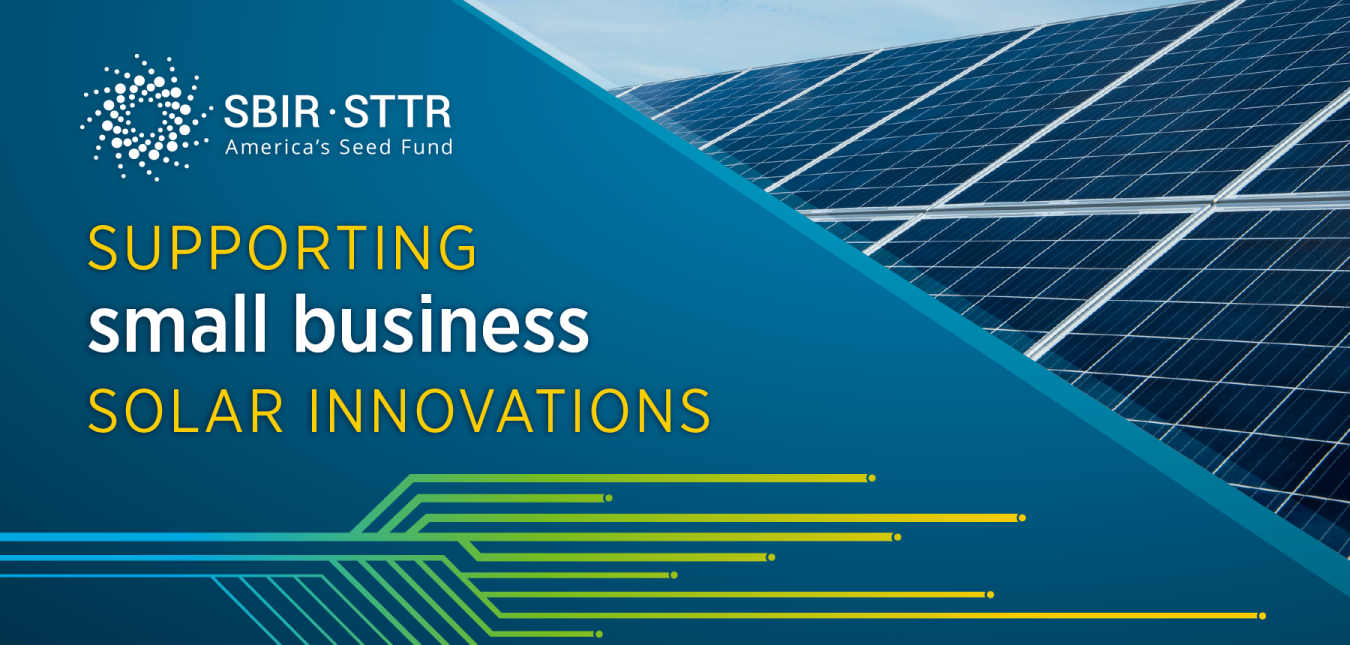Research Area: Manufacturing and Competitiveness
Funding Program: Small Business Innovation Research and Small Business Technology Transfer (SBIR/STTR)
Apply Now: DE-FOA-0002360 (PDF)

Description
The Small Business Innovation Research (SBIR) and Small Business Technology Transfer (STTR) programs encourage U.S. small businesses to engage in high-risk, innovative research and technology development with the potential for future commercialization. The program is administered by the Energy Department’s Office of Science and awards projects in technology areas across the entire department. It is part of the larger SBIR program across the federal government, which is administered by the Small Business Administration. Learn more about these programs’ past awards in solar energy.
SBIR/STTR Phase I awards are up to $200,000 for six months to one year. For help with the application process, visit this webpage on how to apply for a funding opportunity announcement (FOA).
Topic Areas
SETO seeks solutions in the following subtopics:
- 16c. Floating Solar-Powered Aeration Systems – SETO seeks innovations that can advance the application of floating solar-powered aeration systems, which add air to water to support the growth of aerobic bacteria and aquatic life, for natural water systems; sustainable water systems for aquaculture; and sustainable waste bio-processing water systems.
- 16d. Solar Systems Resilient to Weather-Related or Cyber Threats – SETO seeks innovations that improve the ability of solar assets or electronic devices associated with solar energy generation (such as inverters, direct current (DC)-DC optimizers, and smart meters) and systems to quickly recover from weather-related or cyber threats.
- 16e. Innovation in Solar Aesthetics for Residential Photovoltaic Systems – SETO seeks technologies that improve the aesthetic appeal of PV systems for residential applications, either intrinsically or with help from materials that mask the system as another feature of the home.
- 16f. Commercial and Industrial Solar Systems – SETO seeks innovative technologies that can reduce the installed cost of commercial and industrial solar systems, improve their energy yield, facilitate their installation and grid interconnection, and enable additional value streams from them.
- 16g. Agricultural Solar Systems – SETO seeks innovative technologies that can reduce the installed cost of streams from agricultural solar systems, improve the systems’ energy yield, facilitate their installation and grid interconnection, and enable additional value. New system designs and technologies that optimize solar and agriculture production are of particular interest.
- 16h. Components for Generation 3 Concentrating Solar-Thermal Power (Gen3 CSP) Thermal Transport Systems – SETO seeks advanced designs for components of Gen3 CSP systems, including: receivers, hot and cold salt pumps, particle elevators, solid and liquid thermal energy storage systems, low-cost piping and containment insulation, and heat exchangers.
- 16i. Affordability, Reliability, and Performance of Solar Technologies – SETO seeks solutions that lower the cost of solar energy technologies and facilitate their secure integration into the U.S. energy grid. Technologies must be applicable to advanced solar systems integration, CSP, or PV.
The following topic is a collaboration among SETO and other DOE offices and contains a solar subtopic:
20. Conductivity-Enhanced Materials for Affordable, Breakthrough Leapfrog Electric and Thermal Applications (CABLE): Materials and Applications
- 20f. Electrical Connections for Photovoltaic Modules and Systems – This subtopic calls for innovative technologies and approaches that improve the quality and performance of electrical connections at the PV cell, module, or system level while reducing their cost.
Technology Transfer Opportunities
This funding opportunity announcement also includes two solar technology transfer opportunities for the following innovations developed by National Laboratories:
- 16a. Method for Mechanical Load Testing of Photovoltaic (PV) Modules with Concurrently Applied Stressors and Diagnostic Methods – In addition to funding, this is an opportunity for a non-exclusive license to commercialize a new system developed by the National Renewable Energy Laboratory that tests the durability of PV modules via simultaneous application of light, heat, moisture, system voltage, and mechanical stress.
- 16b. Nanocomposite Barrier Films for PV Applications – In addition to funding, this is an opportunity for companies to get a non-exclusive license to work on and commercialize a new, patented thin-film coating developed by Sandia National Laboratories that can be used as an encapsulant for PV module assemblies and as a barrier coating in other PV applications.
Commercialization Assistance Program
We encourage applicants to apply to the Commercialization Assistance Program. It provides additional funding specifically for commercialization activities. The funding opportunity announcement contains more information about this program and how to apply for this extra funding. The commercialization assistance provider must be selected at the time of application.
The American-Made Network is a great resource for finding commercialization assistance providers and vendors with specific expertise in the solar space. The Network helps accelerate and sustain solar innovation through a diverse and powerful group that includes energy incubators, investors, facilities, and industry partners from across the United States. The Network can help competitors solve pressing technology challenges, forge connections, and advance novel ideas and innovations. It also leverages highly specialized skills, tools, and expertise to strengthen and scale critical connections to support the progress and success of competitors.
Key Dates
| Topics Issue Date: | November 9, 2020 |
| Solar-Focused Topics Webinar: VIEW PRESENTATION (password: FkTqk54N) | November 19, 2020, 1 p.m. ET |
| FOA Issue Date: | December 14, 2020 APPLY |
| DOE FOA Webinar: | December 18, 2020 |
| Deadline for Mandatory Letter of Intent: | January 4, 2021, 5:00 p.m. ET |
| Deadline for Full Applications: | February 22, 2021, 11:59 p.m. ET |
| Expected Date for Selection Notifications: | May 17, 2021 |
Additional Information
Learn more about all the topics for FY 2021 Phase I Release 2 (PDF).
Apply for the FOA (PDF).
For FOA-specific support, contact solar.sbir@ee.doe.gov.
See more funding opportunities from SETO, sign up for our newsletter, and join the SBIR listserv to keep up to date with the latest news.
